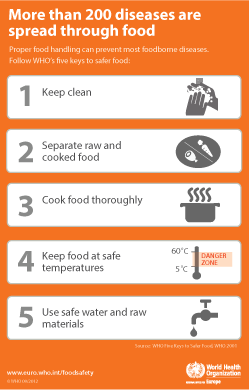Data and statistics

Foodborne diseases are a growing public health problem worldwide, particularly for infants, children, and the elderly.
However, there are no precise and consistent global estimates. To fill this gap, WHO is estimating the global burden of foodborne diseases through the Foodborne Disease Burden Epidemiology Reference Group (FERG).
Foodborne diseases and causative agents in the European Region
- Salmonellosis and campylobacteriosis are the most commonly reported foodborne diseases. They are spread across the whole European Region and transmitted from animals.
- Other foodborne diseases transmitted by animals, such as brucellosis, are a significant public health problem in some areas, such as those around the Mediterranean Sea.
- Diseases from animal parasites, such as trichinellosis and echinococcosis, are also of concern.
- Antimicrobial resistance, which is partly related to usage of antimicrobial agents in animals, is an increasing public health problem.
- Various chemical hazards, such as persistent organic pollutants (POPs), acrylamide, pesticides and dioxin, also represent a public health risk.



